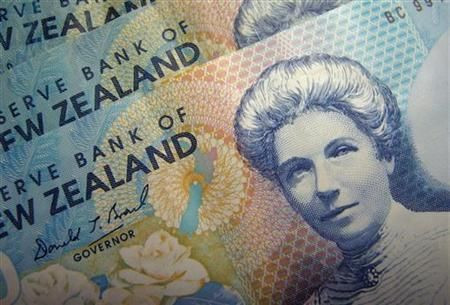Standard & Poor's, Fitch Downgrade New Zealand over Growing Debt

New Zealand suffered its second ratings downgrade within hours Friday as Standard & Poor's cut the country's rating by one notch because of its growing foreign debt, after rival Fitch Ratings' had taken similar action.
This was the first rating cut for the country in 13 years.
Both agencies downgraded New Zealand's sovereign rating to double A from double A-plus, putting it on par with countries such as Kuwait and Abu Dhabi. The revised rating is lower than neighboring Australia's triple A rating but above Japan's double A-minus.
Both agencies classified the outlook for New Zealand as stable.
The rating agencies are expecting New Zealand's external position to deteriorate further, with the current account deficit rising again as markets are growing sensitive to debt.
New Zealand's external position will deteriorate further at a time when the country's fiscal settings have been weakened by earthquake-related spending pressures and fiscal stimulus to support growth, said S&P credit analyst Kyran Curry.
He said New Zealand's strengths were its fiscal and monetary policy flexibility, economic resilience, public policy stability and a sound financial sector.
But those strengths were moderated by high external imbalances, which were accompanied by high household and agriculture sector debt, dependence on commodity income as well as emerging fiscal pressures associated with an aging population.
S&P's move followed a cut by Fitch Ratings overnight, also citing the country's high foreign debt.
SIMILAR TYPE OF STORY
It's a similar type of story to Fitch really, said Goldman Sachs economist Philip Borkin.
The timing is a little bit surprising given that New Zealand has made key progress in improving its imbalances, it's the outlook where you cannot disagree with them, he said.
Fitch, which had New Zealand on negative watch since 2009, is forecasting its persistent current account deficits to widen to 5.5 percent of gross domestic product by 2013. In the quarter that ended June 2011, the deficit was 3.7 percent of GDP.
New Zealand's high level of net external debt is an outlier among rated peers -- a key vulnerability that is likely to persist as the current account deficit is projected to widen again, said Andrew Colquhoun, Fitch's head of Asia-Pacific Sovereigns.
The New Zealand dollar fell to $0.7660 from $0.7698 after the news, but recovered later to $0.7679. It had fallen to a low of $0.7651 earlier because of Fitch.
FUNDING COSTS
The rating cut is expected to increase New Zealand's borrowing costs, although marginally as global yields fell on a bleak outlook.
We expect the impact of New Zealand's international borrowing costs will be a marginal increase, perhaps 5-10 basis points, more so at the long-end of the curve, said Deutsche Bank chief economist Darren Gibbs.
New Zealand's government bond yields rose around 10 basis points, with the long end up 14.5 basis points, steepening the curve. But the rise also followed higher yields elsewhere.
Still, yields have been declining for some time because of uncertain global growth outlook, with the benchmark 10-year bond yields at 4.32 percent, not far from a record low of 4.23 percent struck this week.
The likely increase in funding costs could also delay the timing for interest rate increases in New Zealand.
If funding pressures do intensify...that would delay any interest rate hikes, Goldman's Borkin said.
The Reserve Bank of New Zealand has held its cash rate at 2.5 percent for the past four reviews. It has said it will raise rates when global volatility subsides.
UNDER SCRUTINY
Finance Minister Bill English said New Zealand was under scrutiny because of the debt problems in Europe, even as the government is cutting spending to get the budget back in surplus by the 2014/15 fiscal year.
We have been working to reduce the vulnerability as much as possible over the last two or three years and we have made quite considerable progress, English said in a television interview.
Because of the problem with Italy and Spain, rating agencies are becoming much more hypersensitive to debt.
He said New Zealand is less vulnerable than it was back in 2008 when, ironically, the credit rating was higher.
The other major rating agency, Moody's, has New Zealand at triple-A with a stable outlook, but it focuses more on the level of government indebtedness.
The last time New Zealand's credit rating was downgraded was in 1998, when Moody's cut its rating to Aa2 from Aa1.
New Zealand's rating cut is the latest in a series of downgrades among high-rated developed countries -- including the United States, Japan and Italy -- which suffer from growing debt burdens and weak economic growth.
While these are volatile times, we are expecting global investors to be able to put this news in context and continue to support the NZ government bond market, said Christian Hawkesby, head of fixed income at Harbour Asset Management.
New Zealand's chronic current account deficit has been a longstanding concern for ratings agencies, more so recently because of the heightened global sensitivity to debt.
The country's net foreign debt -- measured by international investment positions -- has steadily improved, sitting last around 70 percent of GDP from a peak of 84.6 percent in March 2009. Australia's level is around 60 percent.
New Zealand's current account deficit was as high as 8.9 percent of GDP in December 2008.
However, the deficit, which hit a 21 year low of 2.5 percent of GDP early last year, is expected to deteriorate as the economy picks up, stoking demand for imports and giving better profits to foreign investors.
Public finances, which have traditionally been a rating strength, have also deteriorated in the past three years.
The government's plans to return to a budget surplus in the 2014/15 fiscal year may be delayed by the reconstruction costs for the Christchurch earthquake in February, Fitch said.
(Additional reporting by Gyles Beckford, Chris Sanders and Wanfeng Zhou; Editing by Richard Borsuk)
© Copyright Thomson Reuters {{Year}}. All rights reserved.





















